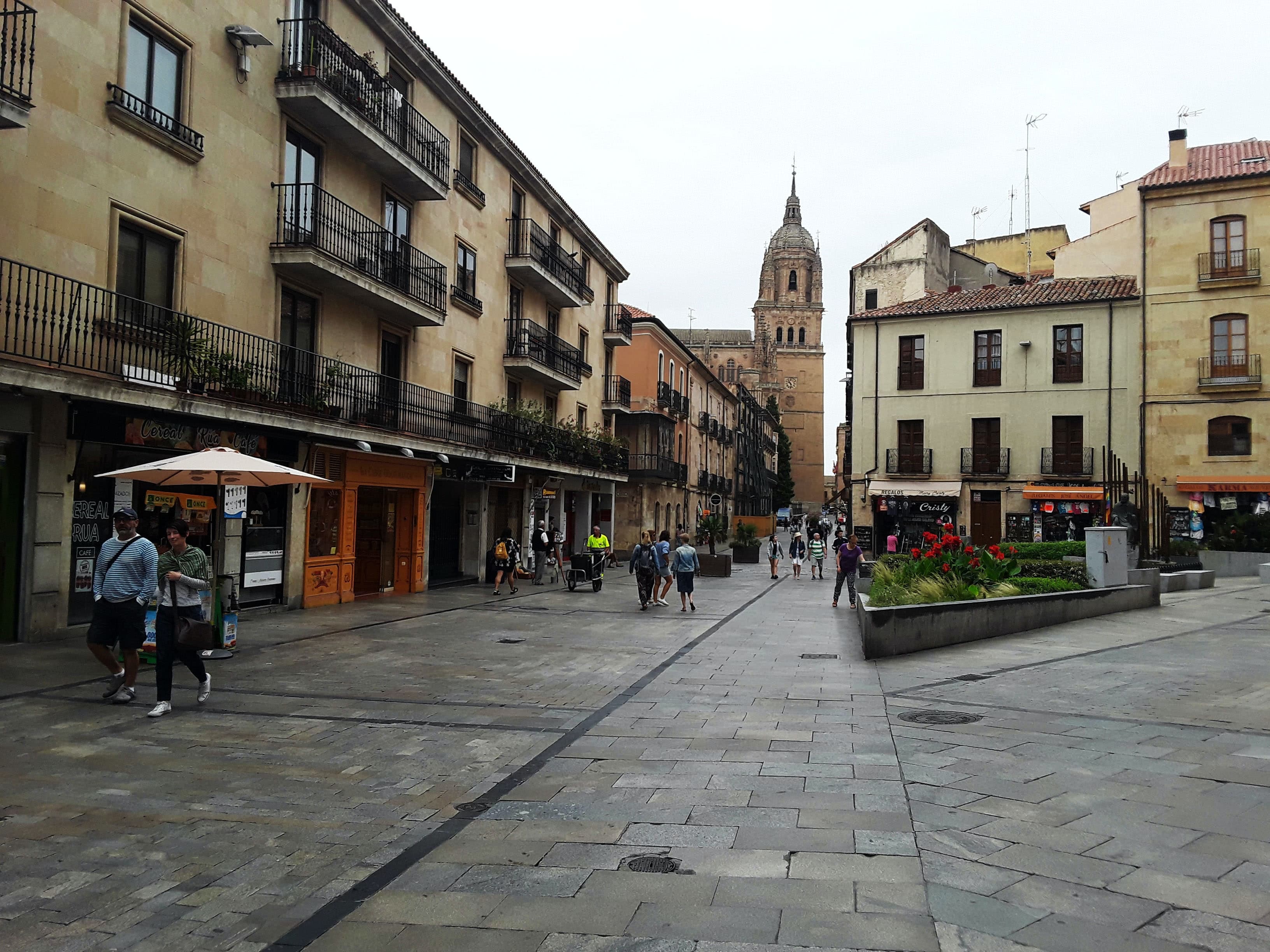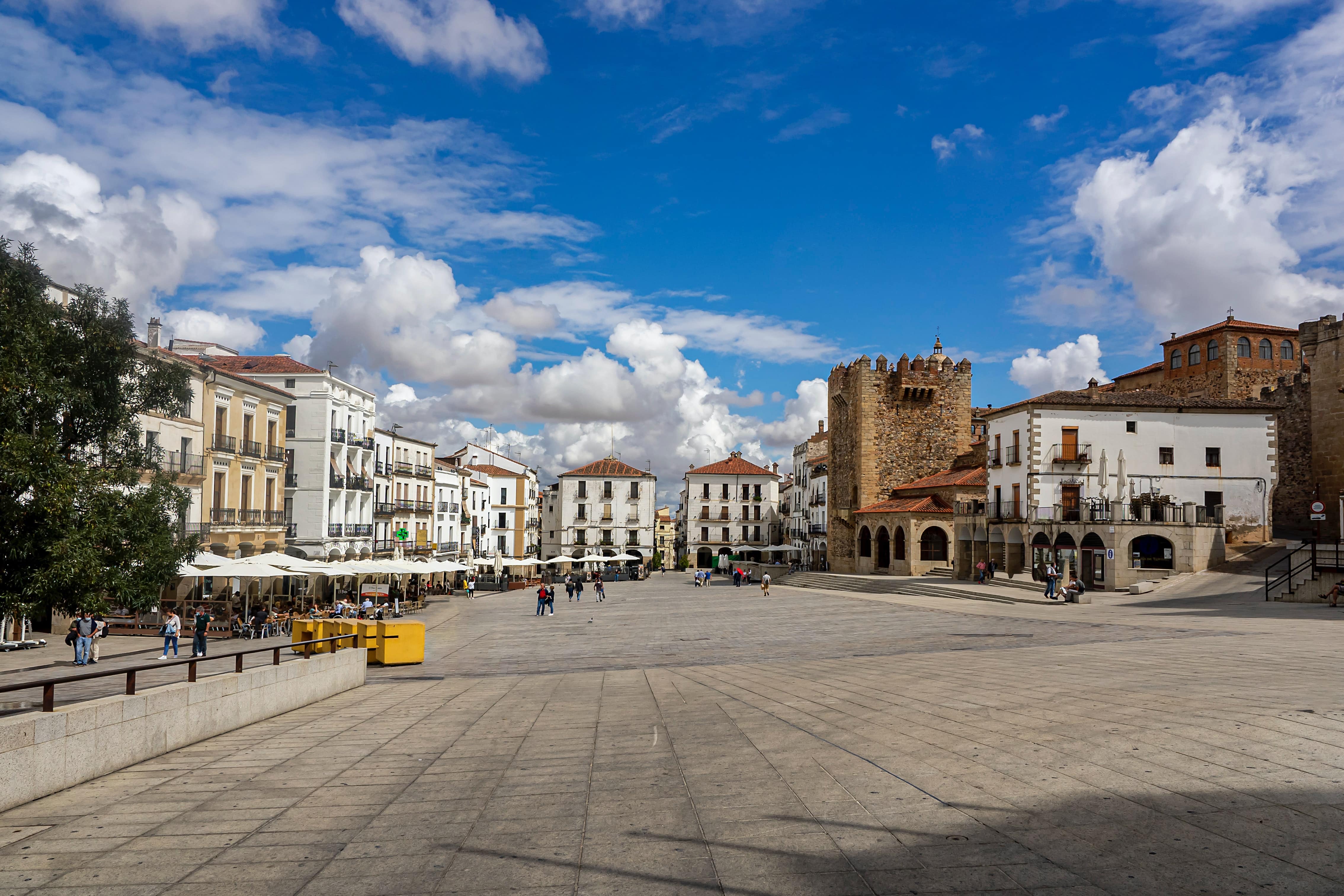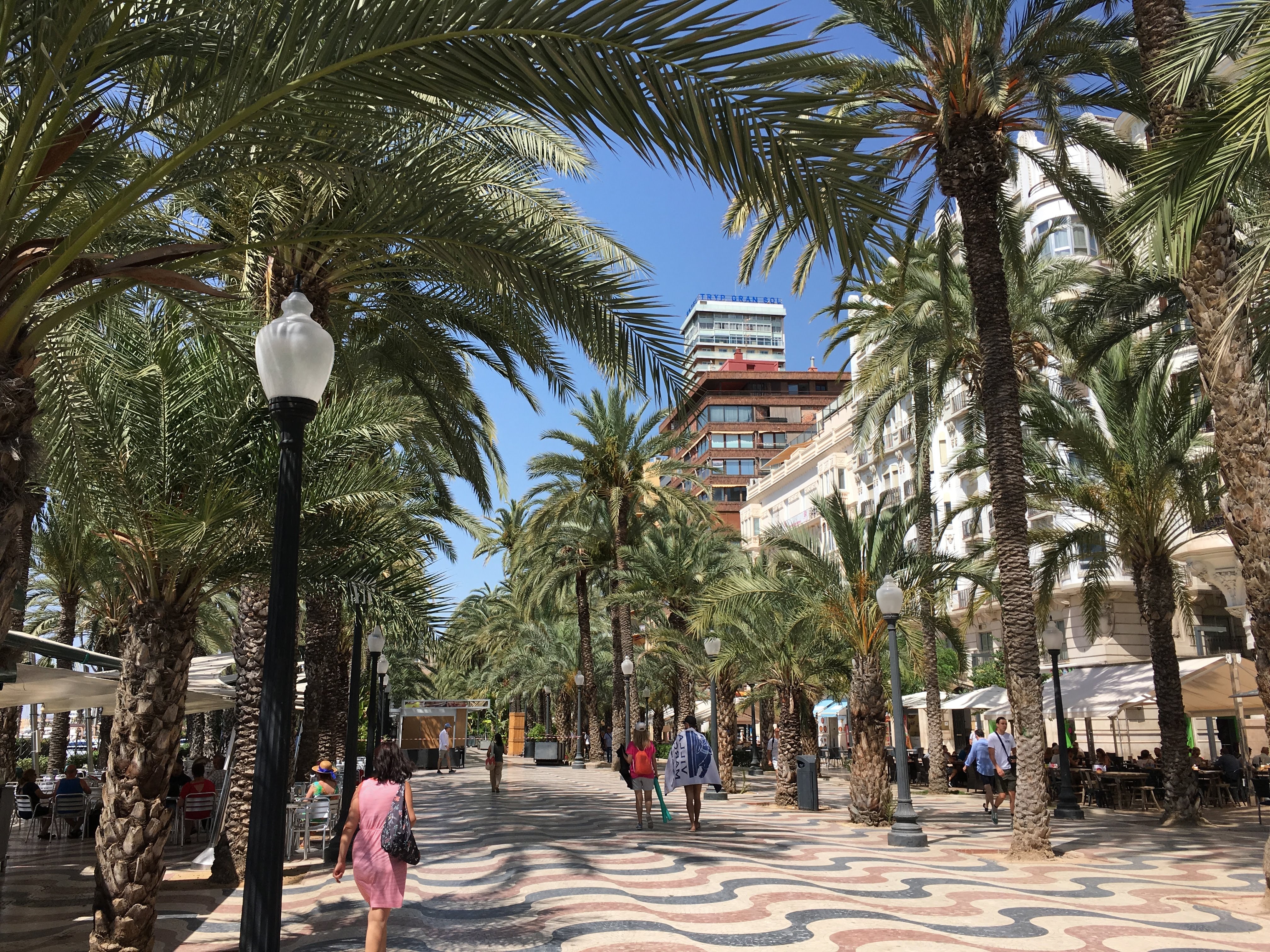
Best Places to Learn Spanish in Spain
What better way to learn Spanish than to immerse yourself in the country that it originated from?
Learning Spanish by immersion is the best approach to quickly pick up a language and have fun doing it.
From the beautiful architecture in Córdoba to the sandy beaches of Alicante or even Logroño’s wine country, Spain is a fantastic place to study and travel.
But where in Spain is the right place for you?
This article will help you find your destination by providing tips on where to learn Spanish in Spain and how to actually do it!
Contents
- Top Spanish Towns and Cities for Learning Spanish
- How to Choose Your Destination
- Tips for Learning Spanish in Spain
- And One More Thing…
Download: This blog post is available as a convenient and portable PDF that you can take anywhere. Click here to get a copy. (Download)
Top Spanish Towns and Cities for Learning Spanish
1. Salamanca
Known as a university town, Salamanca is full of students and other young people. It has several language academies, such as the Don Quijote Spanish Academy.
2. Gijón
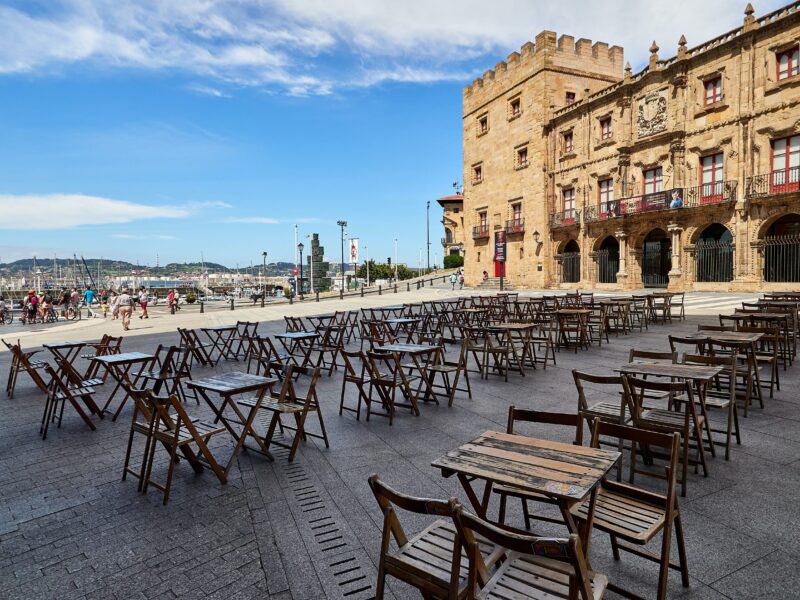
What could be better than learning Spanish next to the beach? Gijón, and the province of Asturias in general, is famous for its surfing, seafood and sidra (hard apple cider).
Check out Lawton School for Spanish classes at all levels, including business-focused classes.
3. Córdoba
Come to Córdoba and be awed by the delicious food and the impressive Moorish architecture.
While you’re there, try the Academia Hispánica, which offers intensive Spanish classes, as well as private and business Spanish instruction.
4. Logroño
Logroño is a small but vibrant city located in the middle of La Rioja, Spain’s primary wine region. Need I say more? In addition to delicious red wine, Logroño is also known for its pintxo (small snack) food culture.
The La Rioja Spanish School offers general and intensive courses—they even offer one that overlaps with Logroño’s annual wine week!
5. Sevilla
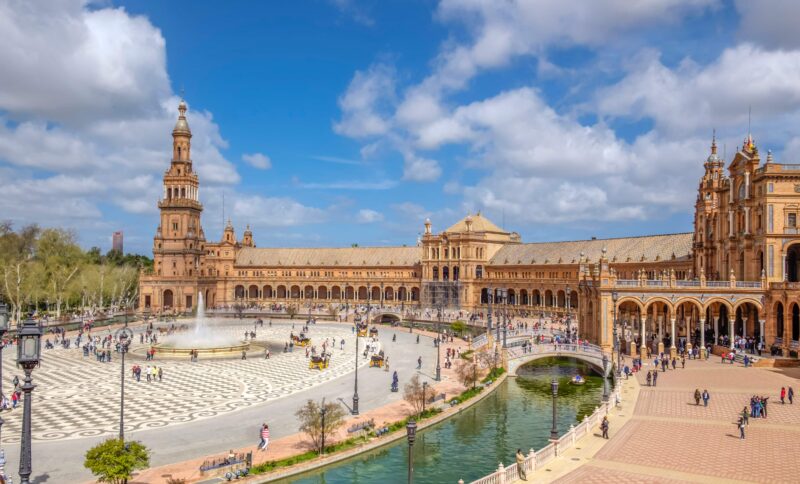
Sevilla isn’t only Andalucía’s capital city, but also a magical place where you’ll be able to experience Spanish traditions like flamenco and eating tapas.
Sevilla Habla offers many types of courses, DELE exam preparation, and even included cultural activities.
6. Toledo

Toledo is one of the oldest cities in Spain, and it was even the capital of the country until the 16th century!
Apart from visiting its old town, with its labyrinth of little streets, you can also learn Spanish with any of the courses Aula Toledo has to offer.
7. Málaga

Beach, sun, good food and happy people. That’s Málaga in a nutshell.
With courses such as “Spanish + Flamenco” and “Spanish + Cooking,” Spanish learning feels like an eternal summer vacation here. Visit AIL Málaga and see which course piques your interest!
8. Bilbao

If you ever visit Bilbao, make sure you go to the fantastic Guggenheim museum.
You can do this while you learn Spanish at the Instituto Hemingway. There’s even a Spanish course for teachers!
9. Valencia

Valencia is known for its paella and its fallas, but there’s so much to discover in this city that you’d need to take a gap year to see it all.
Speaking of gap years, CESA offers gap-year options in addition to the traditional Spanish courses.
10. Cáceres
If you’d like to live and learn Spanish in a city that’s home to a UNESCO World Heritage Site, I really recommend Cáceres.
The Liceo Hispánico is situated just a couple of minutes from the Old Town of Cáceres, the walled medieval city. It offers intensive courses, courses for youths and seniors, as well as internships.
11. Zaragoza

Zaragoza is mainly known among Spaniards for its Cathedral Basilica of Our Lady of the Pillar.
As for Spanish schools, I recommend ALE Zaragoza. It offers general, intensive and conversation courses, among many others.
12. Cádiz

Cádiz has some of the most beautiful beaches in Spain. It’s also famous for its carnival, the biggest in the country and widely known around the world.
Its language school, Spanish in Cadiz, offers standard courses and special combo courses where you can learn how to surf, play guitar and dance flamenco in addition to learning Spanish.
13. Burgos
Burgos is one of the most historically and culturally significant cities in Spain. From El Cid (Rodrigo Diaz de Vivar or “The Cid”) and the Camino de Santiago (The Way of St. James) to the architecture and delicious food, studying Spanish in this city is undoubtedly a delight.
The renowned Burgos University offers plenty of Spanish courses for everybody at every level.
14. Granada

Granada may be a small city, but it’s one of the most beautiful places you’ll ever visit. Apart from its numerous cultural events and charming city center, Granada is known for its Alhambra.
To learn Spanish in this city, pick any of the courses offered by the Escuela Delengua.
15. Santiago de Compostela

Santiago de Compostela is the city where the Camino de Santiago ends. This is where you’ll find the shrine of Saint James the Great.
Whether you’re a pilgrim or just a Spanish learner, the warm and welcoming environment of Santiago will make you feel right at home.
And if you want to work on your Spanish, you can head to the Lorca Institute and sign up for one of the immersive courses.
16. Alicante
Alicante is known for a number of reasons. It has gorgeous Mediterranean beaches, over 3,000 hours of sunlight a year and one of the most vibrant markets in Spain.
There are also plenty of places where you can learn Spanish. For starters, Estudio Sampere offers a variety of courses, from extensive to intensive options and conversation-only courses.
How to Choose Your Destination
Okay, you’ve decided to go to Spain, and now know about some of the best cities for learners. Now you have to choose where you should actually go. With so many options, how do you find what’s right for you?
Spain is made up of 17 autonomous communities (like states), each of which has its own distinctive culture and history. Additionally, the regions in Spain vary in terms of the Spanish that’s spoken there.
Here are some things to keep in mind when choosing a destination in Spain to immerse yourself in the language.
Regional Spanish dialects
Some say that the clearest, easiest-to-understand dialect of Spanish is found in the north-central community of Castilla y León (thus why the language is called castellano).
The nearby areas of Castilla La Mancha and Madrid are also known for their relatively clear Spanish. Cities like León, Burgos and Salamanca are great places for beginners due to their “clear” Spanish dialects.
On the other hand, some of the Southern provinces—particularly Murcia, Córdoba, Extremadura and Cádiz—have a reputation of being slightly more difficult for foreigners to understand.
However, this doesn’t necessarily mean you should avoid these provinces! Learning regional accents and slang may be tricky at first, but it also can be part of the fun of learning Spanish.
Take it from someone who learned Spanish in Extremadura—once you master the regional dialect, you’ll be well prepared to speak Spanish with anyone you meet in Spain.
Other languages besides Castilian Spanish
Many people associate Spain with castellano, but Spain actually has many co-official languages with recognized status in certain autonomous communities. For instance, you can find:
- Basque in Basque Country
- Variants of Catalan in Catalonia, the Balearic Islands and Valencia
- Galician in Galicia
Of course, the vast majority of people you meet in these communities are fully bilingual in castellano Spanish. Many of these territories have some interesting history and politics surrounding language use, so be sure to study up before you set out on your adventure.
Big city vs. Small city
Bigger cities are great places to learn Spanish for a number of reasons. You may find more academies that provide Spanish classes for foreigners or perhaps even a university with Spanish courses.
Additionally, many big cities have language exchanges set up for those who want to practice. For example, Madrid Language Exchange runs four events a week, and Barcelona Languages & Friends runs a weekly event.
On the other hand, small cities and towns have their own benefits. Fewer foreigners mean that you have a better chance of immersing yourself completely in a Spanish-speaking community, without the temptation that comes with being around people who likely speak your own native language.
Don’t be afraid to open your mind beyond the typical tourist destinations in Spain. You may find a small city that you truly fall in love with!
Tips for Learning Spanish in Spain
Attend conversation exchanges and meetups
Many cities in Spain have language exchange groups where you can practice your Spanish and help others with their English. If big groups aren’t your thing, you may also be able to find a one-on-one conversation partner.
Of course, finding these types of events depends on the city where you live, but here are some resources to help find conversation exchanges and meetups:
- Meetup is a great resource for finding language exchange groups and I’d encourage you to find groups that also revolve around you interests outside of language learning.
- Couchsurfing will frequently post announcements for local language meetups as well as other cultural events where you can practice your Spanish.
- Tus Clases Particulares (Your Private Classes) is frequently used by English tutors looking for students. You can post a listing stating that you’re a native English speaker looking to practice Spanish in exchange for English help.
Join an official language school
In many cities in Spain—and even in some small towns—you can find escuelas oficiales de idiomas (official language schools). These language learning institutes are owned and operated by the government, and they offer foreign language classes at highly subsidized prices.
Some, but not all, offer Spanish classes for foreigners, commonly broken up into levels from beginner to advanced.
Escuelas oficiales de idiomas, or EOIs, are great resources for anyone who’s planning to stay in Spain long-term.
Even if you aren’t planning to be in Spain for that long, consider checking out your host city’s EOI anyways. They may host language exchanges, be able to pair you with a conversation partner or offer other language learning resources.
Consume Spanish media
If you’re going to Spain to immerse yourself, then immerse yourself! You are constantly exposed to media and media can be a great way to really dive in to your Spanish learning experience. Watch Spanish news, movies, and TV shows. Read Spanish books and listen to Spanish music.
If you absolutely must watch your favorite TV show in English, consider adding Spanish subtitles so that you’re at least reading along while you watch.
Limit English communication
One of the benefits of learning Spanish in Spain is that you get to be surrounded by your target language all the time. However, you forfeit these benefits if you continue to operate most of the time in English.
Of course, it’s important to be in touch with friends and family back home—they’ll want to know how you’re doing, and homesickness is a real thing! But try to limit the amount of interaction you have in English.
Not only will it disrupt your Spanish immersion, but it’ll also take away from your overall experience.
Live with Spanish roommates
It can be easy for expats in any country to fall into expat-only friend groups. One great way to avoid this is to live with Spanish roommates. That way, you’ll have built-in conversation partners even while you’re at home. Plus, you might get lucky and become friends with your roommate(s).
Finding Spanish roommates isn’t as hard as it may sound. In bigger towns or cities, check websites like Vibbo or milanuncios. (Note that your VPN must be set to Spain to access milanuncios if you’re not in the country.)
In smaller towns, do it the old-fashioned way: Start walking around and look for “Se alquila” (For rent) signs.
Strike up conversations
When it comes to language learning, reading and listening comprehension is only half the battle. To be fully fluent in a language, you have to practice speaking as much as possible.
So, start small—ask someone for directions, ask a waiter what their favorite dish on the menu is, compliment a cashier’s hairstyle. These 30-second conversations may not seem like much, but they’ll work wonders for your confidence and help you achieve fluency faster.
Make mistakes
This is perhaps the most important tip for immersion.
When learning a new language, it’s absolutely inevitable that you’ll make mistakes—even as an advanced speaker! And yes, sometimes those mistakes will be mildly embarrassing.
But don’t let the fear of making mistakes stop you from interacting with native speakers! It’s the only way to learn, and sometimes, those mistakes turn into hilarious stories.
You can prepare for your trip by immersing yourself in Spanish before you even leave for Spain. Just give FluentU a try for an experience that will get you into the immersive spirit before you even arrive to your new home.
FluentU takes authentic videos—like music videos, movie trailers, news and inspiring talks—and turns them into personalized language learning lessons.
You can try FluentU for free for 2 weeks. Check out the website or download the iOS app or Android app.
P.S. Click here to take advantage of our current sale! (Expires at the end of this month.)

Practice vosotros
This is my number-one tip for anyone—particularly Americans—going to Spain to learn Spanish. The vosotros form isn’t commonly taught in American schools, which tend to teach Mexican and Central American rather than European Spanish.
For those of you who are unfamiliar with the vosotros, it’s the second-person plural informal tense. Personally, I like to think of it as the “y’all form.”
While most Spanish-speaking countries in Latin America use ustedes in both formal and informal situations, Spaniards distinguish between the two. So, in Spain, if you’re addressing a group of friends, classmates or acquaintances, you’ll want to learn and practice using vosotros.
Learn the differences between Spanish and Latin American vocabulary
When I moved to Spain, I sometimes felt like I was learning a completely new language—even though I had been studying Spanish since age six!
Just like the differences between British English and American English, Spanish speakers in Spain use many words that you won’t normally hear in Latin America. For example, I was surprised to learn that in Spain a computer is an ordenador (not a computadora) and beans are judías (not frijoles)!
It’s worth taking the time to learn the major differences between Castilian and Latin American Spanish.
Watch Spanish videos
For those who have primarily studied Latin American Spanish, understanding a European Spanish accent can take some adjustment. Prepare before you leave for Spain by watching some Spanish videos online.
The BBC runs a great series of Spanish lessons, including video and audio lessons. Beginners can check out their series “Mi Vida Loca” (“My Crazy Life”) to hear Spain-accented Spanish that’s great for new speakers. Intermediate to advanced speakers can check out BBC Mundo (World) for written and audio news in Spanish.
Intermediate to advanced speakers can also watch the hilarious videos produced by YouTuber Fortfast, who interviews young Spanish people about their lives. You’ll get a sense of the accent as well as Spanish slang—but most of the videos also have Spanish subtitles, which will make them easier to understand.
Advanced speakers can also check out the Spanish TV programming at RTVE or Telecinco.
Now that you know a little bit more about different Spanish regions and cities, you will be able to choose the right place for you to study!
¡Suerte! (Good luck!)
Download: This blog post is available as a convenient and portable PDF that you can take anywhere. Click here to get a copy. (Download)
And One More Thing…
If you've made it this far that means you probably enjoy learning Spanish with engaging material and will then love FluentU.
Other sites use scripted content. FluentU uses a natural approach that helps you ease into the Spanish language and culture over time. You’ll learn Spanish as it’s actually spoken by real people.
FluentU has a wide variety of videos, as you can see here:

FluentU brings native videos within reach with interactive transcripts. You can tap on any word to look it up instantly. Every definition has examples that have been written to help you understand how the word is used. If you see an interesting word you don’t know, you can add it to a vocab list.

Review a complete interactive transcript under the Dialogue tab, and find words and phrases listed under Vocab.

Learn all the vocabulary in any video with FluentU’s robust learning engine. Swipe left or right to see more examples of the word you’re on.

The best part is that FluentU keeps track of the vocabulary that you’re learning, and gives you extra practice with difficult words. It'll even remind you when it’s time to review what you’ve learned. Every learner has a truly personalized experience, even if they’re learning with the same video.
Start using the FluentU website on your computer or tablet or, better yet, download the FluentU app from the iTunes or Google Play store. Click here to take advantage of our current sale! (Expires at the end of this month.)
